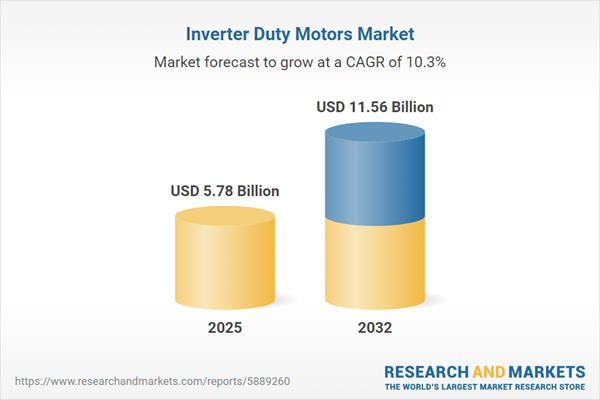Speak directly to the analyst to clarify any post sales queries you may have.
The Inverter Duty Motors Market is being rapidly reshaped by advances in automation, evolving regulatory standards, and industrywide drives toward energy efficiency. For senior decision-makers, aligning with these trends is critical for competitive staying power and operational resilience.
Market Snapshot: Inverter Duty Motors Market Size and Growth Trajectory
The inverter duty motors market grew from USD 5.27 billion in 2024 to USD 5.78 billion in 2025, projected to continue expanding at a CAGR of 10.30% and reach USD 11.56 billion by 2032. This robust growth is linked to enterprises modernizing operations, rising sustainability requirements, and an increased emphasis on digital transformation for asset-intensive industries. The convergence of digital technologies with advanced motor architectures enables greater flexibility and more efficient process control under varied load conditions.
Scope & Segmentation
- Motor Types: Induction Motors, Synchronous Motors.
- Phases: Single Phase, Three Phase.
- Material Options: Aluminum, Cast Iron, Steel.
- Cooling Methods: Air Cooled, Liquid Cooled.
- Power Ranges: High Power (Over 100 HP), Medium Power (11-100 HP), Low Power (Up to 10 HP).
- Applications: Compressors, Conveyors, Fans & Blowers, HVAC Systems, Machine Tools, Pumps.
- End Use Industries: Chemicals & Petrochemicals, Energy & Utilities, Food & Beverage, Mining & Metals, Oil & Gas, Pharmaceuticals, Pulp & Paper, Water & Wastewater Treatment.
- Regions Covered: Americas (United States, Canada, Mexico, Brazil, Argentina, Chile, Colombia, Peru), Europe (United Kingdom, Germany, France, Russia, Italy, Spain, Netherlands, Sweden, Poland, Switzerland), Middle East (United Arab Emirates, Saudi Arabia, Qatar, Turkey, Israel), Africa (South Africa, Nigeria, Egypt, Kenya), Asia-Pacific (China, India, Japan, Australia, South Korea, Indonesia, Thailand, Malaysia, Singapore, Taiwan).
- Leading Companies: ABB Ltd., Adlee Powertronic, AMETEK Bison Gear & Engineering, BODINE ELECTRIC, Brook Crompton Holdings, Columbus McKinnon, Elmech Industries, Fuji Electric, FUKUTA ELEC. & MACH., General Electric, Havells India, HINDUSTAN MOTOR MFG., Laxmi Hydraulics, Lenze SE, Nagpur Motors, Nanyang Harward EX Machinery, Nidec, Oriental Motor USA, Regal Rexnord, Schneider Electric, Shandong Langrui Industrial, Stark Motors, Sumitomo Heavy Industries, TECO-Westinghouse Motors, Toshiba, WEG S.A., Wolong Electric Group, Wonder South East Asia, Yaskawa Electric.
Key Takeaways
- Adoption of inverter duty motors is increasingly driven by compliance with sustainability objectives and the integration of advanced process control systems in manufacturing and utilities.
- Industrial automation and digitalization are reshaping product design, emphasizing real-time condition monitoring, predictive maintenance, and interoperability with IoT platforms.
- Material selection and cooling methodologies, such as liquid cooled solutions, are providing differentiated reliability and performance advantages for applications in harsh or high-demand settings.
- OEM innovation and regional aftermarket expansion allow stakeholders to improve service delivery and meet localized regulatory and operational challenges.
- Strategic partnerships with power electronics and software providers are enabling the deployment of end-to-end motor-drive solutions, reinforcing the value of lifecycle services and system integration.
Tariff Impact: Navigating Cost Structures and Supply Chain Shifts
Recent United States tariffs on inverter duty motors and their components have prompted many manufacturers and procurement leaders to diversify global supplier portfolios and enhance nearshoring strategies. Lifecycle costing models now account for tariff-driven price changes, driving a renewed focus on total cost of ownership and more sophisticated asset management. At the operational level, organizations are extending maintenance intervals on existing assets and leveraging remote diagnostics to mitigate capital outlay, while policy shifts encourage domestic manufacturing and public-private investment into local supply bases.
Methodology & Data Sources
This analysis uses a combination of primary interviews with design engineers, procurement specialists, and maintenance managers, and secondary evaluations of industry reports, regulatory filings, and technical documentation. All findings underwent data triangulation and validation to provide credible, actionable insights specific to inverter duty motors. Quantitative and qualitative trends were analyzed to ensure actionable recommendations.
Why This Report Matters
- Enables executive decision-makers to benchmark technology adoption and understand evolving procurement drivers within inverter duty motors.
- Supports informed strategy development by mapping regional and sector-specific trends with actionable recommendations for supply chain, service, and investment planning.
- Equips stakeholders with insights into tariff implications and optimal approaches for resilience, ROI, and compliance across critical industrial sectors.
Conclusion
Inverter duty motors are transforming how industries manage energy, maintenance, and automation. Insights from this analysis help leaders position for growth, navigate challenges, and optimize performance in an evolving market landscape.
Additional Product Information:
- Purchase of this report includes 1 year online access with quarterly updates.
- This report can be updated on request. Please contact our Customer Experience team using the Ask a Question widget on our website.
Table of Contents
3. Executive Summary
4. Market Overview
7. Cumulative Impact of Artificial Intelligence 2025
Companies Mentioned
The companies profiled in this Inverter Duty Motors market report include:- ABB Ltd.
- Adlee Powertronic Co., Ltd
- AMETEK Bison Gear & Engineering, Inc.
- BODINE ELECTRIC COMPANY
- Brook Crompton Holdings Pte Ltd.
- Columbus McKinnon Corporation
- Elmech Industries
- Fuji Electric Co., Ltd.
- FUKUTA ELEC. & MACH. CO, LTD.
- General Electric Company
- Havells India Ltd.
- HINDUSTAN MOTOR MFG. CO.
- Laxmi Hydraulics Pvt. Ltd.
- Lenze SE
- Nagpur Motors Pvt. Ltd.
- Nanyang Harward EX Machinery And Electronics Co., Ltd.
- Nidec Corporation
- Oriental Motor USA Corporation
- Regal Rexnord Corporation
- Schneider Electric SE
- Shandong Langrui Industrial Co., Ltd.
- Stark Motors
- Sumitomo Heavy Industries, Ltd.
- TECO-Westinghouse Motors (Canada) Inc.
- Toshiba Corporation
- WEG S.A.
- Wolong Electric Group Co., Ltd.
- Wonder South East Asia Sdn Bhd.
- Yaskawa Electric Corporation
Table Information
| Report Attribute | Details |
|---|---|
| No. of Pages | 196 |
| Published | November 2025 |
| Forecast Period | 2025 - 2032 |
| Estimated Market Value ( USD | $ 5.78 Billion |
| Forecasted Market Value ( USD | $ 11.56 Billion |
| Compound Annual Growth Rate | 10.3% |
| Regions Covered | Global |
| No. of Companies Mentioned | 30 |









